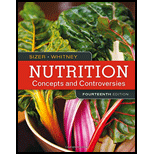
Nutrition: Concepts and Controversies
14th Edition
ISBN: 9781305886865
Author: Sizer, Frances , WHITNEY, Ellie
Publisher: Cengage Learning
expand_more
expand_more
format_list_bulleted
Concept explainers
Question
Chapter 2, Problem 15SC
Summary Introduction
To determine:
Whether evaluating any diet requires comparison with the total food amounts that it provides with those recommended by the USDA eating patterns.
Introduction:
The USDA food patterns have been developed for assisting individuals in meeting their dietary guidelines recommendations. It allows for flexibility regarding how a complete diet could be obtained.
Expert Solution & Answer
Want to see the full answer?
Check out a sample textbook solution
Chapter 2 Solutions
Nutrition: Concepts and Controversies
Knowledge Booster
Learn more about
Need a deep-dive on the concept behind this application? Look no further. Learn more about this topic, health-nutrition and related others by exploring similar questions and additional content below.Recommended textbooks for you
 NutritionHealth & NutritionISBN:9781337906371Author:Sizer, Frances Sienkiewicz., WHITNEY, ElliePublisher:Cengage Learning,
NutritionHealth & NutritionISBN:9781337906371Author:Sizer, Frances Sienkiewicz., WHITNEY, ElliePublisher:Cengage Learning, Nutrition Through The Life CycleHealth & NutritionISBN:9781337919333Author:Brown, Judith E.Publisher:Cengage Learning,
Nutrition Through The Life CycleHealth & NutritionISBN:9781337919333Author:Brown, Judith E.Publisher:Cengage Learning, Nutrition: Concepts and Controversies - Standalo...Health & NutritionISBN:9781305627994Author:Frances Sizer, Ellie WhitneyPublisher:Brooks Cole
Nutrition: Concepts and Controversies - Standalo...Health & NutritionISBN:9781305627994Author:Frances Sizer, Ellie WhitneyPublisher:Brooks Cole Nutrition Through the Life Cycle (MindTap Course ...Health & NutritionISBN:9781305628007Author:Judith E. BrownPublisher:Cengage Learning
Nutrition Through the Life Cycle (MindTap Course ...Health & NutritionISBN:9781305628007Author:Judith E. BrownPublisher:Cengage Learning

Nutrition
Health & Nutrition
ISBN:9781337906371
Author:Sizer, Frances Sienkiewicz., WHITNEY, Ellie
Publisher:Cengage Learning,

Nutrition Through The Life Cycle
Health & Nutrition
ISBN:9781337919333
Author:Brown, Judith E.
Publisher:Cengage Learning,


Nutrition: Concepts and Controversies - Standalo...
Health & Nutrition
ISBN:9781305627994
Author:Frances Sizer, Ellie Whitney
Publisher:Brooks Cole


Nutrition Through the Life Cycle (MindTap Course ...
Health & Nutrition
ISBN:9781305628007
Author:Judith E. Brown
Publisher:Cengage Learning